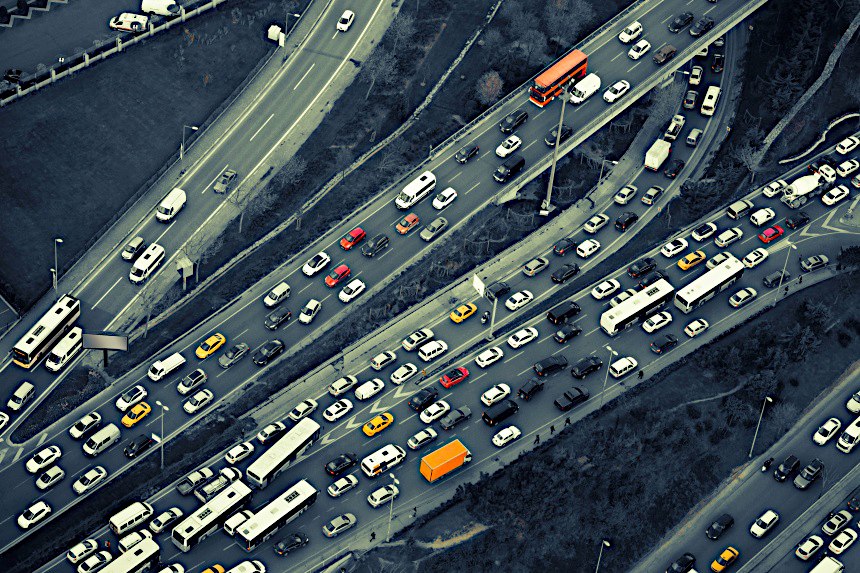I have a problem with Chicago.
Every time I’m in the city, I find myself surrounded by terrible drivers. The highway traffic is dense, of course, but Chicagoans have a habit of exacerbating the congestion by driving with impatience and mania. They follow too closely, brake too often, and cause me unnecessary stress while I’m trying to enjoy WBEZ and daydream about a weekend in Andersonville.
The weird thing is that St. Louis drivers are the same way! Dallas and Denver, too. Bad drivers seem to follow me — an exemplary motorist — everywhere.
I talked to Benjamin Seibold to get some clarity on everyone else’s bad driving. Seibold is an Associate Professor of Mathematics at Temple University and the director of the Center for Computational Mathematics and Modeling, and he says that the tendency for traffic to become a stop-and-go situation is as natural and dependable as the winds of Lake Michigan.
Seibold has spent years researching “phantom traffic jams.” These are traffic jams resulting in stop-and-go traffic that occur for no apparent reason. We’ve all experienced one: you’re driving along in moderate to heavy traffic and suddenly there’s a holdup. Once you’re able to get up to speed again you realize there wasn’t an accident or construction site to cause the jam. So what gives?
“With congestive flow, it’s clear that everyone will go slower, but it would be possible for everyone to go slowly but steadily. Once traffic density reaches a certain threshold, then this uniform speed is dynamically unstable,” Seibold says. “So, that instability means that if you perturb the system a little, it doesn’t go back to it; it moves away from it.” In other words, we are scientifically unable to maintain good traffic flow during rush hour. Phantom jams are the result of collective driving behavior. Those small perturbations — engine hiccups, lane changes, decreases in speed from road curves or otherwise — amplify congestion in traffic.
Phantom jams are inevitable whenever human drivers are involved. To prove this, Seibold’s team performed an experiment in which 21 drivers drove in a circle. They created traffic waves (stop-and-go traffic) that resulted from the cumulative speed imperfections of all drivers in spite of each individual driver behaving somewhat predictably.
Video of how a jamitron progresses on a circular road. (Source: http://math.mit.edu/projects/traffic/)
The problems with stop-and-go traffic, other than being an annoyance, are that it’s costly and dangerous. Fuel consumption, and therefore emissions, is higher during traffic jams, and accidents are more likely. As Seibold puts it, “A higher number of strong braking events in travel is an indicator of collision risk, and traffic jams create these conditions in abundance. Uniform travel flow results in less than five percent of strong braking events.”
In the aforementioned experiment, Seibold’s team found a remedy to the traffic waves that made a significant difference. By inserting one autonomous car into the circle of human drivers, the researchers were able to stabilize the traffic waves caused by the 21 hopelessly flawed drivers. In the traffic scenario without the self-driving car, overall fuel consumption was 40 percent higher, but when the self-driving car was included, emissions of carbon dioxide were decreased by 15 percent and nitrogen oxides by 73 percent.
Does this mean we should be releasing fleets of robot cars to keep us in line on the highways? Or at least in Chicago? Maybe, but widespread driverless vehicles could still be many years away. There are other practical solutions, like variable speed limits shown on LED signs or ramp meters to control highway merging. These fixes can only go so far, however, and, as Seibold says, they depend largely on driver compliance and awareness.
So why not just teach people to be better drivers? While we might never be able to display the perfect vehicular control of a self-driving car, surely we could improve the overall flow of traffic by encouraging a steady gas foot. After all, the U.S. Forest Service’s recommendations for eco-driving seem to line up with the kind of driving that stabilizes traffic flow: smooth and slow acceleration and deceleration, maintaining a constant speed, etc. Seibold says it’s a long shot. “There is no way to naturally change the way people drive like this on a large scale,” he says.
These traffic waves exist independently of many other variables of travel. The fundamental laws of traffic flow are relatively uniform all over the world. Other countries have very different laws for highway speeds and overtaking, but it turns out that traffic flow, as it is impacted by density and how stop-and-go traffic happens, are rather similar in all countries, Seibold says. That said, generally in the southwest U.S., people are more accepting of traffic flow, and on the east coast there is more aggressiveness in driving behavior that can make jams more severe.
To Professor Seibold, the most interesting thing about studying traffic is finding the behavioral patterns that emerge in complex human systems that are not initially visible. To a mathematician, these patterns, like traffic waves, resemble phase transitions (like vaporization) or detonation waves (explosions). “If we want to improve our traffic systems,” he says, “understanding the connections between these phenomena is important.”
So, the movement of individuals is as predictable as natural laws and apparently not guided by some city-wide ignorance. Perhaps Chicagoans aren’t especially bad drivers. Regardless, on my next trip, I’ll be taking the train.
Featured Image: Repina Valeriya on Shutterstock
Become a Saturday Evening Post member and enjoy unlimited access. Subscribe now




Comments
Interesting article Nicholas about another problem (like the plastics you wrote about recently) that also just keeps getting worse.
Taking the train sounds like a great idea, be it to Chicago or anywhere else. I know Atlanta has one of the very few great transportation systems anywhere in the U.S., using it when I was there on business several years ago. I didn’t want to leave; had to mentally force myself (kicking and screaming) to return to L.A.
The phantom traffic jams are extremely aggravating, and I’m glad (at least) there’s a name for it, and the problem is being studied. I don’t know how long things can continue like this, and have asked myself are we heading toward the day everything stops?
No, but we should be heading toward a time (at least) of vast improvement. Unnecessary tech device overkill and primitive driving conditions simultaneously, day in and day out, are two examples of extremes contributing to why Americans are so stressed out and messed up. This is leaving out poor diets, lack of sleep, coffee/energy drink addictions and many other contributing factors.
Ultimately it’s not sustainable, just like the plastics problem you wrote about recently. As with most things historically, the problem(s) will have to get SO bad before the drastic changes needed will come about to bring the needed solutions. I’m sure there are people that already have the solutions, but don’t have the power or means to bring them about; never mind the costs and bureaucracy. Possibly something by the turn of the next century? For the duration of the 21st anyway, we’re pretty much stuck with what we’ve got trying to get anywhere.